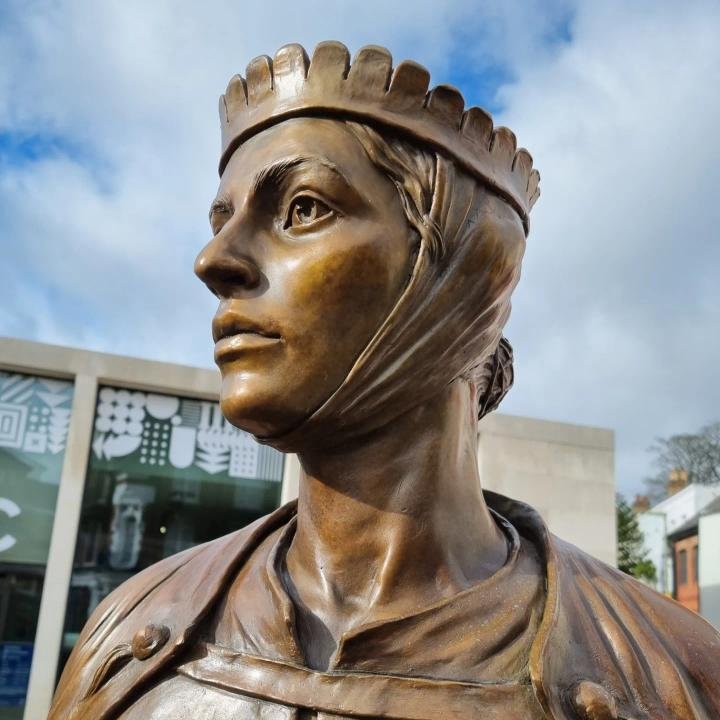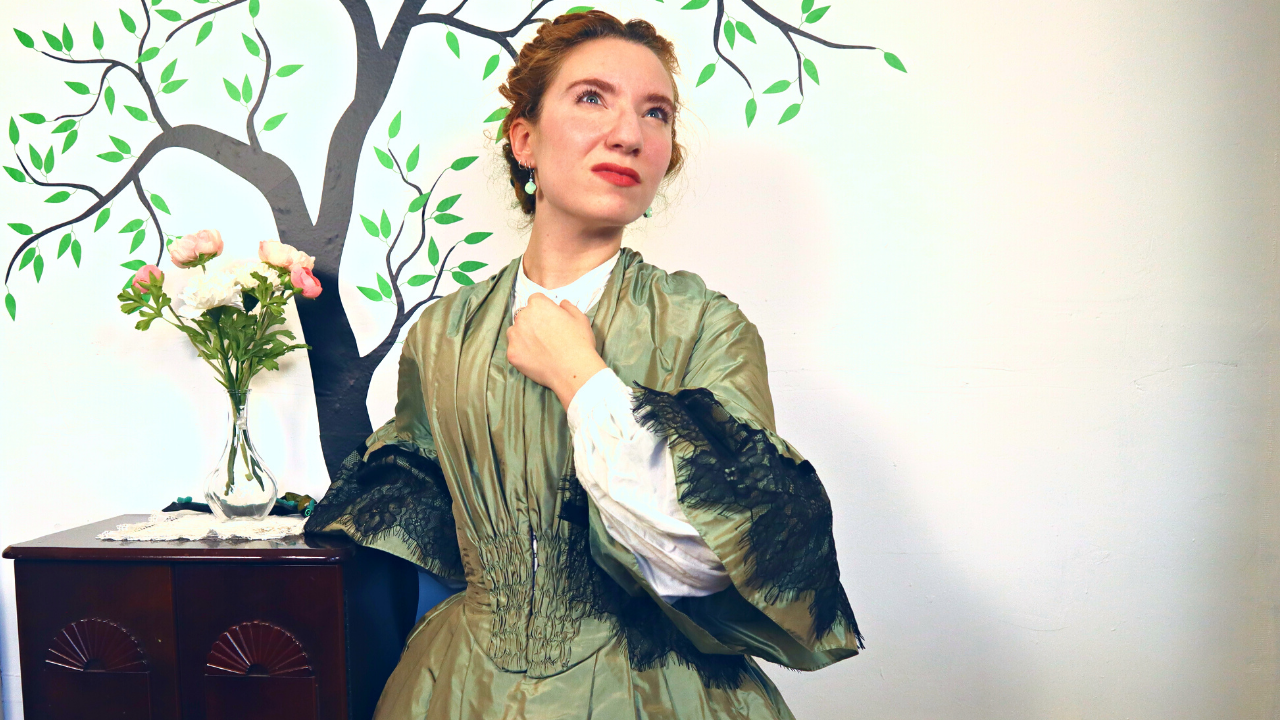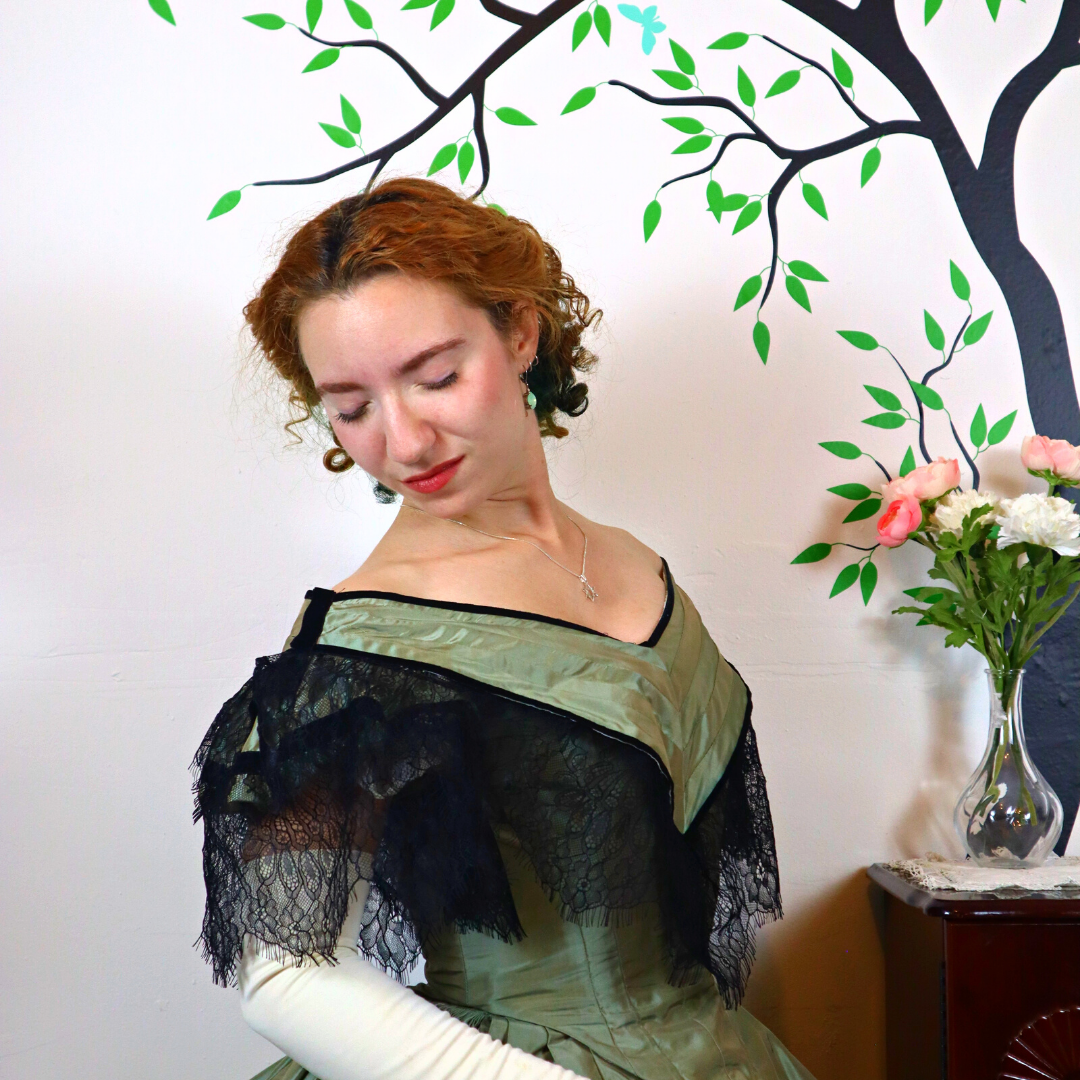What did medieval Jews wear? 13th and 14th Century Hair and Veil tutorial
What did medieval Jews wear? 13th and 14th Century Hair and Veil tutorial
Medieval women in Europe wore veils according to Christian custom, but what about medieval Jews? Jewish women in the middle ages wore veils over their hair too, and were required to wear ones with a double blue and white border in 13th century Italy. As a Jewish woman who likes medieval dress, this seemed like a great addition to the 14th century medieval hair tutorial and veil demo I'd been planning!
Reclaiming Jewish dress
Historically, identifying dress has been a traumatic subject for Jews, but there's some fascinating Jewish history behind this simple piece of headwear which makes it a part of Jewish culture in a way most forms of antisemitic dress never were. Marginalized people, including Jews, BIPOC, and queer and trans folk are often erased from our ideas of medieval history. In reality Europe was still diverse in the middle ages-- so by wearing obviously Jewish dress, I'm hoping to get reenactors and history fans thinking about what's missing from the picture of history they're used to.
-
[singing blessing] Baruch atah Adonai, Eloheinu Melech haolam, asher kid’shanu b’mitzvotav v’tsivanu l’hadlik ner shel Hanukkah.
Hi! Welcome back to my channel. I’m SnappyDragon, you can call me V, and here we do Stitchy Business! I finally have the long-promised medieval hair and veil tutorial you wonderful people asked for after I made my Quarantine Kirtle. But also, it’s Hanukkah, and it seemed like a good idea to explain why this veil is not like other veils! {wrong holiday, we know} I found a reference to a particular style of veil worn as identifying dress by Medieval Jewish women. While most examples of identifying dress are very traumatic for Jews to see and wear, this one has an interesting history that might make it a bit easier to reclaim, allowing me to dress as an Obviously Jewish person and hopefully get people thinking about their preconceived notions of how homogenous medieval Europe was, or wasn’t. We’ll talk about this in much more depth in a moment, but first, let’s sew some headwear.
The veil is a circle of linen 30 inches in diameter, marked and cut out using an improvised compass. I’m using cotton thread because of how this veil will be decorated later, and hemming all the edges with the tiniest hem I can manage.
I’m also sewing a “fillet”, which is a linen headband that serves as the foundation of the headdress. This is a simple rectangle cut on the straight grain— a previous attempt to cut on the bias, per the Medieval Tailor’s Handbook ended in squiggly disaster— folded in half with all the edges turned inwards. It’s then “oversewn”, or whipstitched all around. Two small pieces of twill tape are sewn into each end to tie the fillet around the head.
And now, I should probably explain what the big deal about this veil is . . .
Before I get going, I strongly encourage you not to skip past all the history and heritage talk because it seems boring. Marginalized people often have their stories and voices treated as “boring” or “out of place” and it’s a part of how society silences those without privilege. BUT, if you need help pinning your veil on right this minute, there’s a timestamp in the description.
When in costume, I usually wear English or Scottish fashions, and at reenactments I often play an Irish character. Even out of costume, people ask if my heritage is Irish, Scottish, or British . . . which I suppose shouldn’t surprise me, considering I play fiddle, do Irish and English folk dance, and have red hair.
But I am not any of those things. I’m Ashkenazi Jewish. Like, so completely Ashkenazi Jewish that when a doctor’s office gave me one of those ancestry DNA tests, it came up 99.8% Ashkenazi Jewish. Side note, red hair was used as a symbolic representation of Judaism in the middle ages! This might be where the line about how “redheads have no souls” came from.
In no way does this detract from the fact that I am white, and benefit from white privilege. Whiteness has always been a subjective category for the purpose of exclusion, right back to early English colonial laws which began using the term “white” to strip free, Christian Black men of their upward mobility. Judaism is a weird intersection of religion, culture, and ethnicity, and historically Jews have been bounced in and out of that definition of 'white enough to not persecute right this second’— sometimes considered "non-white", sometimes considered "white but still Other", and sometimes assimilated into white culture. This assimilation and the related promise of safety was often a method of control. Many Ashkenazi Jews, especially in the US, bought into this bargain to persecute other people to maintain their status in “white/white-supremacist” society, including most of my family. It’s done a huge amount of damage to the Jewish people’s solidarity with other marginalized groups, because it’s still very common today. Our survival of persecution should make us greater advocates for BIPOC and others fighting oppression, not lesser, and we have a lot of work to do there.
So, the privileged section of Western society has this story it tells that everyone in history was a certain way: usually white, Christian, and just like them, that diversity is fake and history supports their one-dimensional view of how the world should be. It’s also very common for people not to wonder if anything is missing when they see that lack of diversity, even if they don’t actively hold white supremacist ideas about it. That vision of history isn’t true, though! There were Black people in Britain who came over with the Romans! The Vikings had contact with the Middle East, enough for the Arab writer Ahmad ibn Fadlan to describe being grossed out by their hygiene practices in his journal! And my people have been in Europe for thousands of years, basically getting kicked from place to place by antisemitic rulers.
Talking about my Judaism in the costuming world has gotten mixed reactions. Growing up in the Northeast US where I did, I don’t think I’d encountered the lack of understanding that many Jews experience before? And while lots of the people it came up with were not trying to be antisemitic, I saw variations between utterly forgetting that Jews are a thing— in a lot of ways, the Shoah in Europe worked in erasing us from public understanding— to littler things like not understanding why “religion” is such a big deal to an agnostic person like me, to treating Hanukkah as though it’s some kind of “Jewish Christmas” that I must be preparing a big celebration for. (Sometimes I do, but that’s because I will take any excuse to throw a party. Hanukkah is a very minor holiday whose significance has been blown up and commercialized by— you guessed it! Christmas-normative culture.)
When in costume, sure, sometimes I will play a goyische character so I can move through the world in ways Jews were prevented from doing— sometimes I’m just here to dance with people in a pretty dress. But sometimes, I want people to look at me and think about the fact that they’re seeing a Jew. I don’t want to have my identity erased and become part of that one-dimensional, whitewashed, inaccurate image of history. So when I saw a brief mention on Rosalie Gilbert’s Medieval Woman site of Jewish women wearing veils with a double blue border, I very excitedly dove down the research rabbit hole. Turns out, an edict by Pope Alexander the 4th in 1257 required Jewish women to wear these blue-bordered veils. The book “Handbook to Life in the Medieval World” describes the style and gives it a specific name, the “oralia”.
Some of you are probably going “Wait, V, why would you want to wear a mark of antisemitism as part of your costume?”. Well, because it isn’t just that. This is a complicated topic, because throughout history Jews have been required to wear various identifying clothes as a means of segregation and persecution. I won’t go into detail about more recent and well-known instances to avoid bringing up that collective trauma, but it has a very long history. However, blue and white garments have been part of Jewish culture pretty much for as long as there’s been Jewish culture. It starts with the Torah, our primary religious text, which says that Jews were commanded to attach “tzitzit” (fringes) to our clothes, and each fringe should have a string of “tekhelet”, an extremely expensive blue dye that I’ll talk more about later. The tzitzit fringes, together with the four-cornered garments that were part of Hebrew dress at the time, evolved into what we now know as “tallit”, or prayer shawls, which are traditionally made with blue stripes or borders.
So blue-and-white clothes have long since been part of Jewish culture and have a very positive set of associations for us. Instead of being an antisemitic invention like the badges specified in many similar laws, blue-and-white stripes only became a mark of antisemitism in the hands of non-Jews. This is not the only instance of this happening : this particular style of hat, which became known as a “Jewish Hat”, was seen in manuscripts made by Jews such as the Bird’s Head Haggadah, suggesting it was a Jewish cultural style before it was legally required as identifying dress.
I wouldn’t choose to wear a badge or a red apron or anything else specified in these antisemitic laws outside of a pure reenactment setting, because those things were imposed by outsiders rather than having roots in Jewish culture. Wearing a blue-bordered veil, though, feels like a way to break through that one-dimensional image of history by explicitly dressing as a Jewish medieval woman, without wearing the garments of my people’s oppression. Those blue and white stripes were ours long before they were misappropriated by non-Jews.
I’m sketching out my borders using a compass to measure— a three-quarter-inch-wide outer border, and a half-inch-wide inner one. I found no details on how these borders looked or were arranged, so this is guesswork. This pencil should wash out.
The blue dye mentioned in the Torah, “tekhelet”, is kind of a fuzzy concept. We’re not sure if it refers to a visual color, or a dyestuff made from a sea creature known as the chillazon. Period sources describe the color as “hyacinth”, “blue as the midday sky”, and “indigo”. We also don’t really know what the chillazon is; much like dress historians tearing their hair out over the phrase “finish in the usual manner”, this was probably such common knowledge that no one bothered to describe it. Two different Israeili scraps of cloth from the 1st century CE were dyed blue with dye from the sea snail H. trunculus, so that seems like a strong contender.
I do not have the time nor resources to go yoinking sea snails out of the Mediterranean and turning them into dye! So like most Medieval people I’ll use whatever’s easy to get. In my case, that’s Jacquard Dye-Na-Flow, and I’ve mixed two colors to make a deep blue shade like what the H. trunculus snail produces. I’ve covered my worktable in plastic, and secured the veil in place with fabric weights. The paint can be applied with a brush, but it’s quite watery and bleeds a lot, so there will be a great deal of patience required.
Once the paint is dry, it’s ironed for 3 minutes under a pressing cloth, then washed in cold water with special textile detergent.
And now, as promised, the hair and veil pinning demonstration you were waiting for! I’ll first divide my hair into two braids at either side of my head. Loop the braids up over your ears and secure in place using your preferred method, be that period hair taping or modern hairties and bobby pins.
The edict about this veil is from the 13th century, so I’ll start with a more 13th-century arrangement and then show the 14th century style from the kirtle video. Start by tying the fillet, which is the foundation of the headwear, across the top of the forehead and around the head so it sticks up vertically a bit in the front. Now, drape the veil over your head so it crosses the fillet at the temples. Pin it in place here. There are purpose-made veil pins which might be nicer for this, but since I don’t dress in medieval clothes very often, I’m using my blue glass-headed sewing pins. They match, right? For extra security, you can even catch some of the braided hair in the pins.
And, here we go! This super-simple style is historically . . . appropriate? adequate? acceptable? For the 13th century.
Now for the 14th century! The hair stays the same, but the fillet is tied across the top of the forehead around to the nape of the neck.
The fabric grain is key to getting the drapery of this style. Rotate the veil so the straight grain is vertical, then fold the front edge under and drape it over your head. That folded front goes across the fillet and forehead, and then I’m making two small folds backwards that cause the veil to flare out around my face. This will give us the wide, fashionable silhouette of the 14th century. The veil is pinned to the fillet through those folds. If you wanted to wear a wimple, you could very easily put that on first and then arrange your veil in this exact same way over it.
And here we have it! Some fairly straightforward medieval hair and headwear. I’m hoping that, were I seen at an event in this veil, it would help observers to consider that not every “medieval” person fit that White, Christian, normative idea of the past— and perhaps even think about what assumptions they would make about me or my character if I wasn’t wearing such an obvious mark of difference. Once we can have things like events and reenactments again, I’m excited to be able to dress in the clothes of my people, in a way that won’t bring up generational trauma for my fellow Jews.
Likewise, I hope this video made you think! Please like, subscribe for more stitchy and occasionally Opinionated Historical content, and don’t start any trainwrecks in the comments section, because you’re better than that. Happy Hanukkah, Holidays, and New Year to you and yours, may you be well and safe and happy, and I will see you . . . next year, I guess! Happy sewing~





